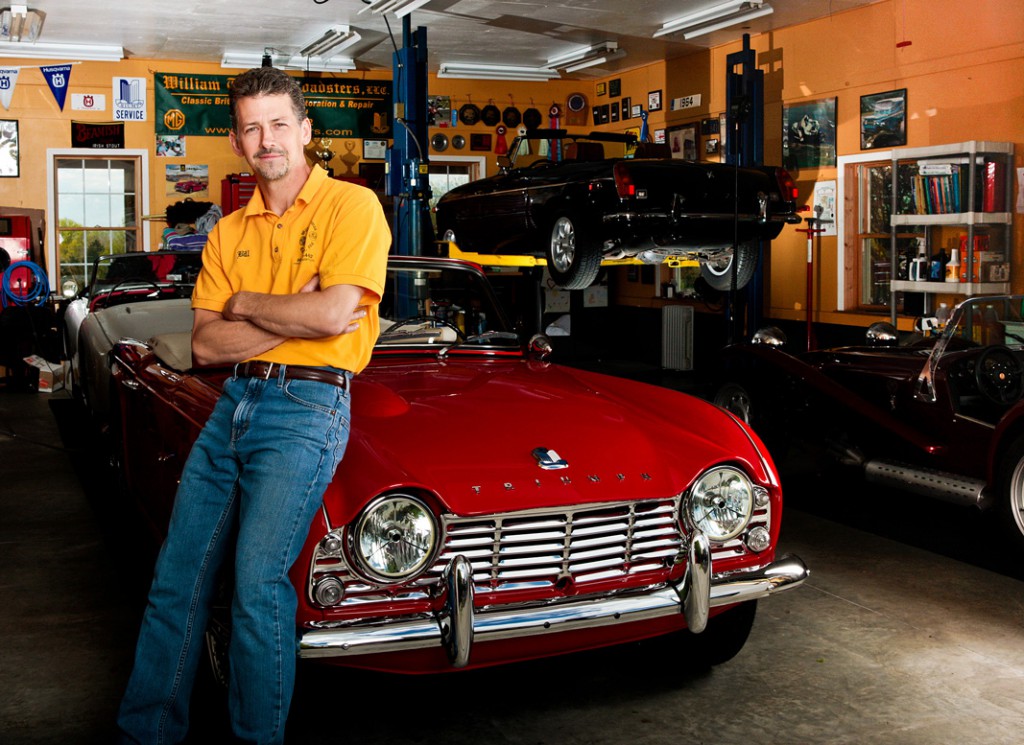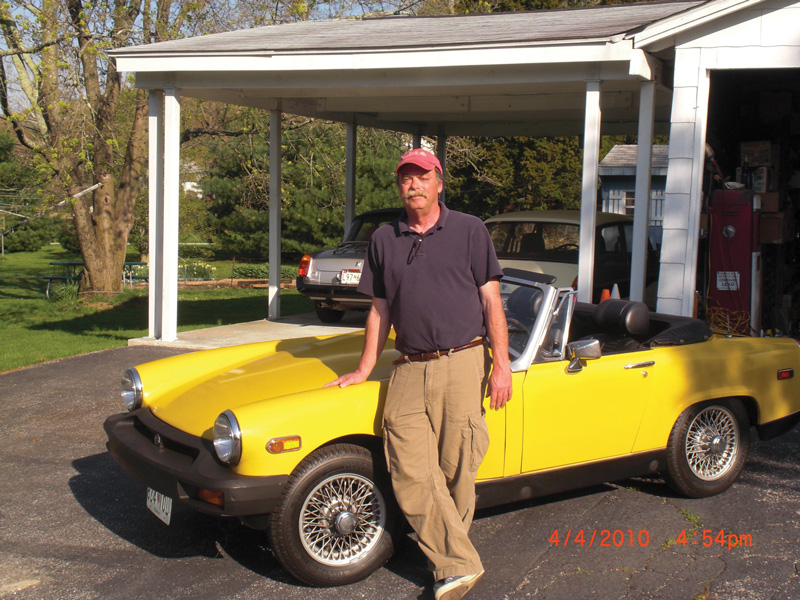New tires provide better handling and safety, plus vintage looks
Old cars are a thrill…old tires are a hazard. While our beloved Austin-Healeys, MGs and Triumphs sit idle in the garage, the tires they stand on are hardening, cracking and crumbling away due to aging and the environment.
Many purists want to keep their classic car outfitted with original equipment, especially the guys competing in concours d’elegance. Judges award extra points for running period-correct tires, going so far as checking tire date codes. Some owners argue they’re only logging say, a hundred miles per season, so why bother putting on new tires when the old ones are barely used. But how do you think 40-year-old tires are holding up?
The tread blocks might still stand tall and look fresh, but problems probably lurk beneath. No matter the number of miles driven, experts say a tire can become unsafe in just five years—the rubber and other components lose their ability to perform. 
There’s no sense risking your car or yourself due to rotting rubber. We agree, new tires often appear out of place on a classic car. Thankfully, a few tire companies like Coker Tire and Universal Tire are producing period-correct tires for our classics. You can even get redlines.
How can we make such a definitive statement about replacing old tires? Because we tested a set of never-used old tires against a set of new vintage-looking tires, and the results raised eyebrows. But we had our proof.
The Test For Proof
Here’s how it came down. A friend of ours had been storing a set of never-used Michelin X redline tires for decades, intended for a perfect concours Triumph he’s slowly restoring. His intentions were good, but he didn’t consider that although each tire was stored in a plastic bag in a barn, there is still no protection from the aging process.
We decided to test the saved Michelins against a set of new vintage-looking tires, Universal’s Vredestein Sprint Classic. Despite its modern construction materials and date stamp, the Vredestein has a classic tread pattern, tall sidewall and period lettering.
We rustled up eight 15×5-inch steel Triumph TR6 wheels, one set for the 33-year-old 185R15 Michelins paired with fresh Carlisle inner tubes, and the second set for brand-new, H-speed rated 185R15 Vredestein Sprint Classic tires.
A two-part test seemed appropriate for the tires fitted to a Triumph TR6. First was a real-world road test to evaluate each tire for comfort and noise on fresh asphalt, aged pavement and concrete with expansion joints. Second was a performance handling test at the track, including an emergency lane change and braking test.
Old Tires Don’t Measure Up
We had problems with the old Michelins before we even got them on the car: Small cracks developed between the tread blocks during the mounting process. Once mounted, we noticed the Michelins outweighed the Vredesteins by a few pounds due to the inner tube.
On the road, the Michelins had a heavy, clumpy feeling over bumps, struggling to follow the roadway’s irregularities and instead skipping over them. There was ample kickback through the steering wheel and cowl shake.
The Michelins were also measurably loud at 95 db. Vibrational resonances seemed to come and go independent of road speed, as if the tire was going in and out of balance.
Time spent on track with the Michelins wasn’t pleasant. The TR6 refused to turn at times and violently spun at other times. Unpredictability was the key descriptor regarding these tires, followed by a notable lack of grip and traction. We averaged 47.2-second laps around the Ocala Gran Prix, a Central Florida kart track.
Trying to stop the TR6 from 60 mph on 33-year-old tires was also a challenge—strong braking resulted in immediate lockup. With many braking exercises, we got the braking distance down to 160 feet, not great by today’s standards, but still half what we measured in the first attempt. Think about that for a second.
The emergency lane change maneuver was also troublesome. Slow response, followed by unpredictable and violent oversteer, gave us the chills. Frankly, we’d avoid using tires this old for rolling across the show field, let alone a highway drive or even a parade through town.
New Vintage Tires Perform Well
In comparison, the Vredestein vintage-looking tires performed well on the TR6. The tall sidewall of the 185R15 size is roughly equivalent to an 80-series tire, much taller than a typical modern radial but appropriate for a classic sports car.
These tires allowed more relaxed shifting and provided far more comfort over bumps than the older tires. The sidewall compliance and soft spring rates felt perfectly matched as the car buzzed down the road.
The Vredesteins had a slight, pleasant hum. Peak noise from the tire’s resonance point—we took our readings at about 40 mph—was 93 db and nearly indistinguishable from other road and wind noise. While the Michelins were only 2 db louder, don’t forget that decibel readings are exponential.
The Vredesteins also performed well on the track. They had enough grip to get around corners with authority and provided nice, progressive breakaway characteristics. While these tires lack the outright grip of modern radial race tires, you won’t embarrass yourself at a marque-club autocross with them either. Our lap times of 44.7 seconds are respectable and beat the old tires by two-and-a-half ticks.
Braking revealed the Vredesteins’ biggest advantage— they only needed a little more than 140 feet to stop from 60 mph. Unlike the old Michelins, braking with the Vredesteins was consistent and predictable, with only slight lockup on the front brakes during the last few feet of the test. The Vredesteins also aced our 35-mph emergency lane change, as the Triumph snaked through the left-right-left chicane with no drama whatsoever.
Lessons Learned
Too often people take their tires for granted, and classic car enthusiasts are no different. All is assumed okay if tires are still sporting tread and holding air. Unfortunately, a tire past its prime can look safe yet still be dangerous.
For about $150 a piece, a modern, vintage-looking tire like the Vredestein Sprint Classic can be an inexpensive insurance policy for your cherished classic. You’ll appreciate these comfortable, safe and properly sized tires for daily use that won’t let you down in an emergency situation. Plus, they look just right with wire wheels, chrome bumpers and a set of Lucas fog lamps.
This article comes courtesy of testing performed by the Classic Motorsrports magazine staff.
Follow-up Letter
I read with great interest the article entitled “Fresh Rubber,” especially the opening paragraphs concerning the effects of aging on tires. My ’67 TR4A needed four new tires, so I called Coker and they supplied four new tires. However, upon arrival the tire technician noticed some drying and cracking. By reading the build date code, it was discovered the tires were 10 years old! Coker was called and the company was quite good about sending a brand-new set of tires. The tire tech said the original set were totally unfit to be placed on the car and would have led to an accident. This story’s moral: check the build date of any tire you place on your vehicle.
– Michael Robbins








'Fresh Rubber – Getting the right tire for the job' have 6 comments
August 18, 2015 @ 8:40 am Larry
Read your article “Fresh Rubber” and I have a question.
When replacing original tires like the TR6 redlines with tubes, can the newer tires be mounted and used
without having an inner tube installed? Is so, would it be a good idea to use a tube anyway?
Thanks
October 6, 2015 @ 7:02 am Marc Duste
I just acquired a 1970 TR6 out of 20+ years of storage with a nice but hopelessly old set of Goodyear G800 185SR15 tires. I know they must be replaced and will go with 205/70-15’s, but I cannot find a definitive answer to whether inner tubes need to be used with the original steel wheels.
Your article doesn’t state if tubes were used on the Vredstien tires, and the follow-up question on this topic went unanswered.
What is needed to safely fit modern tires to a TR6 with steel wheels?
Regards
Marc in SF
October 27, 2015 @ 8:20 am Ken Braithwaite
I am about to purchase a ’72 TR6 with wire wheels and am wondering if a car with wires was fitted with Red Lines or not? I have to purchase new tires and as such I want yobget it right. I’ve never seen the wire wheeled cars with Red Lines. Thank you. My Best always. Ken
April 6, 2022 @ 9:14 am Tim Mulrenan
I am the original owner of a ‘73 TR6, which I still have and drive regularly. I’m responding to the comment in April 2022, so a little late. Nevertheless Dunlop’s were original equipment in ‘73. I believe Triumph went to Michelin X redlines as original equipment in ‘74.
April 7, 2025 @ 7:10 pm Bob Lesage
I ordered my 74 TR6 with steel wheels new with the optional Michelin redlines, Goodyear Blackwalls were standard. The Michelin tires with tubes were required for cars with wire wheels. I now have Goodrich 205/70 tires on the car now.
January 8, 2024 @ 7:28 pm Dennis Devore
I have a ’65 E Type Jaguar Coupe, and was on our club spring outing – the “Dust Off”. We left Denver, and taking back roads wound our way down to Colo. Springs where we had lunch. On the return, via the Interstate, I had a blow out while entering the Denver area. Upon having AAA change the tire, it was found that the Michelin was 23 yrs. old! What luck.